Rheostat range limiting
PARTS AND MATERIALS
CROSS-REFERENCES
Lessons In Electric Circuits, Volume
1, chapter 5: "Series and Parallel Circuits"
Lessons In Electric Circuits, Volume
1, chapter 7: "Series-Parallel Combination Circuits"
Lessons In Electric Circuits, Volume
1, chapter 8: "DC Metering Circuits"
LEARNING OBJECTIVES
SCHEMATIC DIAGRAM
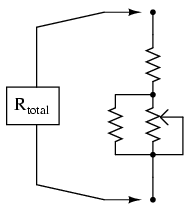
ILLUSTRATION
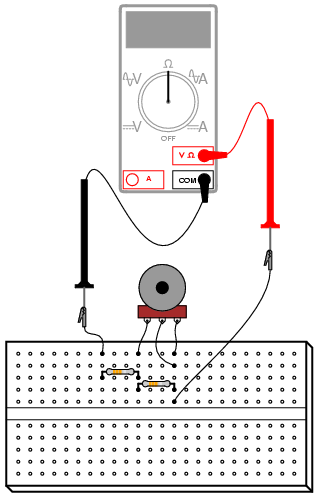
INSTRUCTIONS
This experiment explores the different
resistance ranges obtainable from combining fixed-value
resistors with a potentiometer connected as a rheostat. To
begin, connect a 10 kΩ potentiometer as a rheostat with no
other resistors connected. Adjusting the potentiometer
through its full range of travel should result in a
resistance that varies smoothly from 0 Ω to 10,000 Ω:
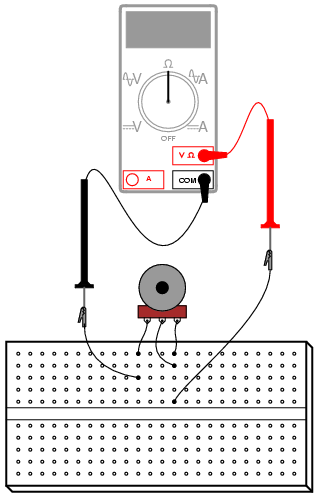
Suppose we wanted to elevate the lower end
of this resistance range so that we had an adjustable range
from 10 kΩ to 20 kΩ with a full sweep of the potentiometer's
adjustment. This could be easily accomplished by adding a 10
kΩ resistor in series with the potentiometer. Add one
to the circuit as shown and re-measure total resistance
while adjusting the potentiometer:
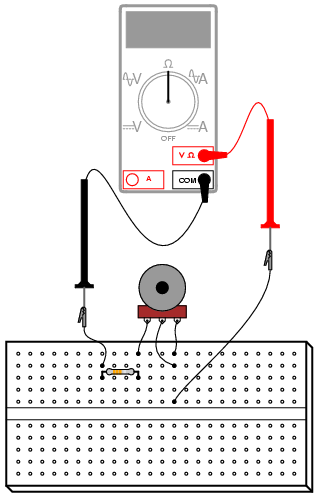
A shift in the low end of an adjustment
range is called a zero calibration, in metrological
terms. With the addition of a series 10 kΩ resistor, the
"zero point" was shifted upward by 10,000 Ω. The difference
between high and low ends of a range -- called the span
of the circuit -- has not changed, though: a range of 10 kΩ
to 20 kΩ has the same 10,000 Ω span as a range of 0 Ω to 10
kΩ. If we wish to shift the span of this rheostat circuit as
well, we must change the range of the potentiometer itself.
We could replace the potentiometer with one of another
value, or we could simulate a lower-value potentiometer by
placing a resistor in parallel with it, diminishing
its maximum obtainable resistance. This will decrease the
span of the circuit from 10 kΩ to something less.
Add a 10 kΩ resistor in parallel with the
potentiometer, to reduce the span to one-half of its former
value: from 10 KΩ to 5 kΩ. Now the calibrated resistance
range of this circuit will be 10 kΩ to 15 kΩ:

There is nothing we can do to increase
the span of this rheostat circuit, short of replacing the
potentiometer with another of greater total resistance.
Adding resistors in parallel can only decrease the span.
However, there is no such restriction with calibrating the
zero point of this circuit, as it began at 0 Ω and may be
made as great as we wish by adding resistance in series.
A multitude of resistance ranges may be
obtained using only 10 KΩ fixed-value resistors, if we are
creative with series-parallel combinations of them. For
instance, we can create a range of 7.5 kΩ to 10 kΩ by
building the following circuit:
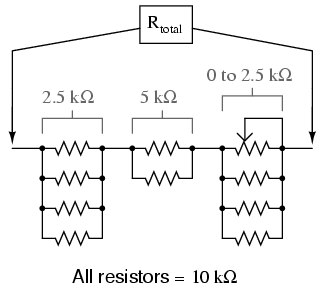
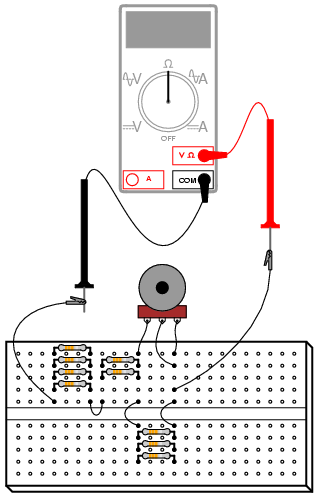
Creating a custom resistance range from
fixed-value resistors and a potentiometer is a very useful
technique for producing precise resistances required for
certain circuits, especially meter circuits. In many
electrical instruments -- multimeters especially --
resistance is the determining factor for the instrument's
range of measurement. If an instrument's internal resistance
values are not precise, neither will its indications be.
Finding a fixed-value resistor of just the right resistance
for placement in an instrument circuit design is unlikely,
so custom resistance "networks" may need to be built to
provide the desired resistance. Having a potentiometer as
part of the resistor network provides a means of correction
if the network's resistance should "drift" from its original
value. Designing the network for minimum span ensures that
the potentiometer's effect will be small, so that precise
adjustment is possible and so that accidental movement of
its mechanism will not result in severe calibration errors.
Experiment with different resistor
"networks" and note the effects on total resistance range. |